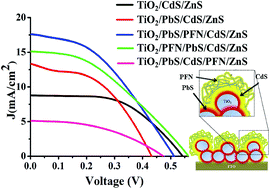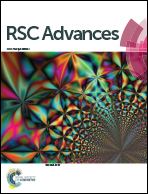Current improvement in hybrid quantum dot sensitized solar cells by increased light-scattering with a polymer layer
Abstract
We investigate the effect of the incorporation of a material with efficient electron transport into a Hybrid Quantum Dot Sensitized Solar Cell (HyQDSSC). The performance of different quantum dot sensitized solar cells is compared with a cell containing poly [(9,9-bis(3′-(N,N-dimethylamino)propyl)-2,7-fluorene)-alt-2,7-(9,9-dioctylfluorene)] (PFN) with structure TiO2/PbS/PFN/CdS/ZnS. The photoconversion efficiency, as compared to our reference samples, was enhanced in some cases by approximately 45%, while the short-circuit current increased by up to 100% after the incorporation of PFN. The deposition order of the different components was crucial in achieving these improvements. Diffuse reflectance and impedance spectroscopy were used to study the behaviour of the cells. The observed enhancements are attributed to increased light scattering in the active layer, better charge transport, and a decrease in charge recombination and transport resistance.


 Please wait while we load your content...
Please wait while we load your content...